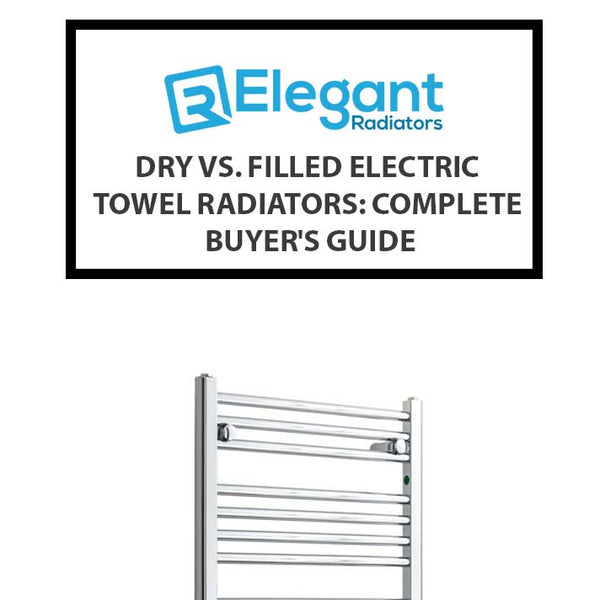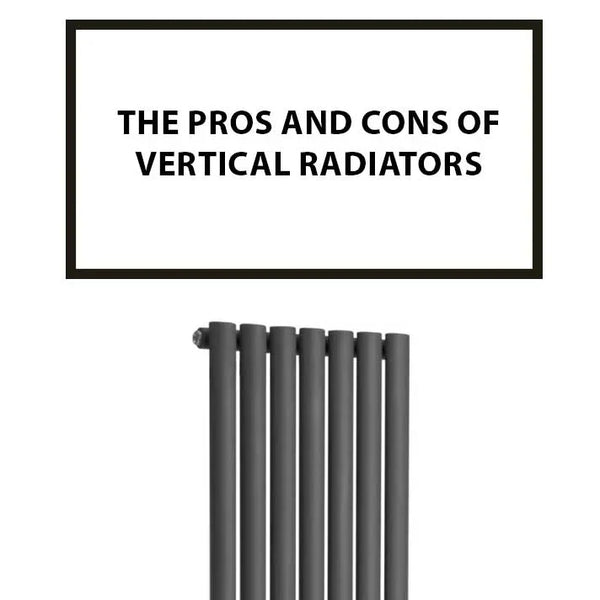Dry vs. Filled Electric Towel Radiators: Complete 2025 Buyer's Guide

Selecting the perfect electric radiator for your property whether you're a homeowner upgrading your heating, a landlord outfitting rental properties, or a tradesperson specifying systems for clientsm requires understanding the fundamental differences between dry electric radiators and filled (thermal fluid) electric radiators.
While both technologies deliver 100% energy-efficient heating at the point of use and feature advanced smart controls, their internal mechanics create distinctly different performance characteristics. This comprehensive guide examines everything from heat-up times and running costs to installation requirements and room suitability, empowering you to make the optimal choice for each space in your property.
What you'll learn in this guide:
- How dry and filled electric radiators work internally
- Real-world performance differences (speed, consistency, energy use)
- Accurate running cost comparisons
- Room-by-room recommendations
- Installation requirements and considerations
- Money-saving tips for electric heating
1. Electric Radiator Technology Explained: What's Inside Matters
Understanding how your electric radiator generates and distributes heat is crucial for predicting its real-world performance, from response times to energy consumption patterns.
Dry Electric Radiators: Direct Heat Technology
Dry electric radiators operate without any internal liquid, using heating elements embedded directly within the radiator body to generate warmth.
Two main types of dry heating elements:
- Aluminium Elements - Deliver rapid heat-up (warm within 60 seconds), ideal for quick warming
- Ceramic Core Elements - Superior heat retention using high-density ceramic bricks that absorb and slowly release heat
Key advantages of ceramic dry radiators:
- Retain heat for 30-45 minutes after switching off
- Reduce heating cycle frequency, improving efficiency
- Emit up to 50% radiant heat (warms people and objects directly)
- Lightweight and often DIY-friendly to install
Filled Electric Towel Radiators: Thermal Fluid Technology
Filled electric radiators (also called oil-filled or thermal fluid radiators) use an internal heating element to warm a specialized propylene glycol-based thermal fluid, which then circulates throughout the radiator body.
Benefits of the thermal fluid system:
- Superior heat retention - Continues radiating warmth for 60-90 minutes after power-off
- Even heat distribution - Circulating fluid eliminates cold spots across the entire surface
- Silent operation - No kettling or gurgling noises
- Corrosion prevention - Anti-corrosion inhibitors protect internal components
- Antifreeze protection - Safeguards down to -7°C
- Consistent ambient warmth - Ideal for maintaining steady room temperatures
Internal fluid composition: The thermal solution is a non-toxic, purpose-engineered propylene glycol mixture specifically formulated for optimal heat transfer, longevity, and silent operation—far superior to water-based systems.
2. Performance Comparison: Heat-Up Time, Efficiency & Running Costs
This detailed comparison reveals how the internal technology of each radiator type translates into real-world performance, helping you match the right system to your heating needs.
2.1 Heat-Up Time: Responsive vs. Sustained Heating
Dry Electric Radiators:
- Aluminium models: Noticeable warmth in 1-2 minutes
- Ceramic models: Maximum temperature in 10-15 minutes
- Best for: Spaces needing immediate heat on-demand
Filled Electric Radiators:
- Heat-up time: 25-35 minutes to reach full operating temperature
- Fluid circulation ensures gradual, even warming
- Best for: Maintaining consistent comfort over extended periods
2.2 Heat Retention: The Efficiency Trade-Off
The critical difference in real-world efficiency lies in heat retention after the radiator stops drawing power:
- Dry ceramic radiators: Continue radiating for 30-45 minutes
- Filled radiators: Continue radiating for 60-90 minutes
Energy efficiency implication: Filled radiators cycle on and off less frequently to maintain temperature, potentially reducing overall electricity consumption in continuously heated spaces by 10-15%.
2.3 Heat Distribution: Radiant vs. Convective Warmth
Dry Ceramic Radiators:
- Emit 50% radiant heat (warms people and objects directly)
- Particularly effective in high-ceiling rooms or draughty spaces
- Concentrated warmth where the radiator is positioned
Filled Radiators:
- Primarily convective heat (warms the air, which circulates)
- Eliminates cold spots through even fluid distribution
- Creates consistent ambient temperature throughout the room
- Completely silent operation (no moving parts)
2.4 Running Costs: How Much Do Electric Radiators Cost to Run?
Important: Running costs depend on wattage, usage patterns, and your electricity tariff—not just the radiator type.
Sample cost calculation (using UK average electricity rate of £0.30/kWh):
| Radiator Wattage | 1 Hour Cost | 6 Hours/Day | Annual Cost (6hrs/day) |
|---|---|---|---|
| 500W | £0.15 | £0.90 | £329 |
| 1000W | £0.30 | £1.80 | £657 |
| 1500W | £0.45 | £2.70 | £986 |
Cost-saving strategies:
- Use programmable thermostats and timers (both types support this)
- Set accurate target temperatures (every 1°C reduction saves ~10%)
- Zone your property (heat occupied rooms only)
- Take advantage of longer heat retention (especially with filled models)
Real-world efficiency: While both types are 100% efficient at converting electricity to heat, filled radiators' superior retention means they can maintain comfort with less frequent power draw in continuously heated spaces.
3. Installation: DIY-Friendly vs. Professional Integration
Installation requirements differ significantly and may influence your choice based on your property setup and budget.
Dry Electric Radiator Installation
Typical features:
- Lightweight construction (easier single-person handling)
- Often includes mounting brackets for wall installation
- Optional radiator feet available (freestanding use)
- Some models plug-in ready (though smart models require hardwiring)
Installation options:
- DIY wall mounting (basic models with plug)
- Professional hardwiring (smart/programmable models)
- Freestanding placement (with optional feet)
Best for: Rental properties, quick installations, rooms without existing wiring infrastructure
Filled Electric Towel Radiator Installation
Typical features:
- Heavier due to internal fluid (usually requires two people)
- Must be professionally hardwired by qualified electrician
- Permanent, integrated installation
- No visible cables or plugs
Installation requirements:
- Qualified electrician for mains connection
- Secure wall mounting (supporting fluid weight)
- Compliance with electrical regulations (Part P in UK)
Best for: Permanent installations, multiple radiators throughout property, professional finish
Cost consideration: Professional installation adds £100-£300 per radiator but ensures compliance, safety, and warranty validity.
4. Design & Aesthetics: Form Meets Function
Dry Electric Radiators
Design characteristics:
- Typically compact, minimalist profile
- Limited style variation (function-focused)
- Heating element placement fixed for optimal distribution
- Available finishes: Usually white, occasionally chrome
Best suited for: Modern, minimalist interiors where compactness is prioritized
Filled Electric Towel Radiators
Design characteristics:
- Extensive style range (traditional to ultra-modern)
- Greater design flexibility due to fluid distribution
- Available in multiple formats:
- Ladder-style towel rails
- Flat panel radiators
- Column radiators (traditional)
- Designer statement pieces
Available finishes:
- White powder-coated
- Polished chrome
- Anthracite/Matt black
- Brushed brass
- Custom RAL colors
Best suited for: Design-conscious homeowners, boutique properties, heritage buildings, luxury bathrooms
5. Room-by-Room Recommendations: Which Type Where?
The optimal radiator choice depends entirely on the room's function, size, and usage patterns. Here's a professional zoning approach:
Choose Dry Electric Radiators For:
✓ Guest Bedrooms & Holiday Homes
- Irregular usage patterns requiring on-demand heat
- Fast warm-up eliminates waiting time
- Lower initial cost if infrequent use
✓ Small Home Offices
- Quick morning warm-up for work-from-home schedule
- Radiant heat warms person directly (doesn't waste energy heating empty space)
- Compact footprint
✓ Conservatories & Extensions
- High proportion of glazing and heat loss
- Radiant heat more effective than convective in draughty spaces
- Rapid response to changing conditions
✓ Utility Rooms & Garages
- Spaces needing occasional heating only
- Fast response when doing laundry or workshop tasks
- Budget-friendly option for secondary spaces
Choose Filled Electric Towel Radiators For:
✓ Primary Bedrooms & Living Rooms
- Maintaining comfortable temperature for extended periods
- Superior heat retention reduces energy cycling
- Silent operation crucial for bedrooms
✓ Bathrooms
- Many models IP-rated for safe bathroom installation
- Even heat distribution prevents cold spots
- Gentle, consistent warmth preferred for bathroom comfort
- Towel warming capability (ladder-style models)
✓ Open-Plan Living Spaces
- Larger room volumes benefit from consistent heat retention
- Even distribution prevents temperature gradients
- Creates ambient background warmth throughout space
✓ Nurseries & Children's Rooms
- Consistent, gentle temperature ideal for sleep
- No surface temperature spikes
- Completely silent operation won't disturb sleep
✓ Rental Properties (Primary Heating)
- Professional appearance with hardwired installation
- Lower running costs benefit tenants
- Reliable, low-maintenance operation
6. Quick Comparison Table: Dry vs. Filled Electric Radiators
| Feature | Dry Electric Radiators | Filled Electric Radiators |
|---|---|---|
| Heat-up time | Very fast (1-15 mins) | Moderate (25-35 mins) |
| Heat retention | Good (30-45 mins) | Excellent (60-90 mins) |
| Heat distribution | 50% radiant/50% convective | Primarily convective |
| Operation noise | Silent | Silent |
| Weight | Lightweight | Heavy (due to fluid) |
| Installation | Often DIY-friendly | Professional hardwiring required |
| Portability | Can be freestanding | Fixed installation only |
| Design options | Limited | Extensive range |
| Best for | On-demand, irregular use | Continuous, consistent heating |
| Ideal room size | Small to medium | Medium to large |
| Running costs* | Identical watt-for-watt | Identical watt-for-watt |
| Bathroom suitable | Yes (check IP rating) | Yes (check IP rating) |
| Maintenance | Minimal | Minimal |
| Typical price | £150-£400 | £200-£600 |
*Running costs identical for same wattage, but filled radiators may cycle less frequently due to better heat retention
7. Making Your Decision: The Professional Approach
Decision-Making Framework
Answer these questions for each room you're heating:
1. Primary heating need:
- Quick heat on-demand? → Dry radiator
- Steady, all-day warmth? → Filled radiator
2. Usage pattern:
- Irregular/occasional use? → Dry radiator
- Continuous daily use? → Filled radiator
3. Installation preference:
- DIY or plug-in preferred? → Dry radiator (basic models)
- Professional permanent installation? → Filled radiator
4. Design importance:
- Functional, compact unit sufficient? → Dry radiator
- Specific style to match décor? → Filled radiator (more options)
5. Room characteristics:
- Small/medium with high ceilings or draughts? → Dry radiator (radiant heat)
- Large/open-plan needing even warmth? → Filled radiator
The Hybrid Approach: Best of Both Worlds
Professional tip: Many properties benefit from a zoned system using both technologies strategically:
- Filled radiators in primary living spaces (bedrooms, living room, open-plan areas)
- Dry radiators in on-demand spaces (guest rooms, home office, utility room)
This hybrid approach optimizes both performance and budget, ensuring each room has the ideal heating technology for its specific use case.
8. Energy-Saving Tips for Electric Radiators (Both Types)
Regardless of which technology you choose, these strategies maximize efficiency:
✓ Smart thermostatic control
- Use programmable thermostats (both types support this)
- Set heating schedules matching occupancy
- Lower temperature 30 minutes before leaving
✓ Zone heating
- Heat only occupied rooms
- Close doors to heated spaces
- Use TRVs or individual radiator controls
✓ Optimize temperature settings
- Living areas: 19-21°C
- Bedrooms: 16-18°C
- Bathrooms: 22°C (when in use)
- Each 1°C reduction saves approximately 10% on running costs
✓ Leverage heat retention
- For filled radiators: Switch off 30-60 mins before leaving (residual heat continues)
- For ceramic dry radiators: Switch off 15-30 mins before leaving
✓ Insulation & draught-proofing
- Any radiator's efficiency improves with proper insulation
- Seal windows and doors
- Use thermal curtains
- Insulate walls and loft spaces
✓ Regular maintenance
- Keep radiators dust-free (improves heat distribution)
- Ensure nothing blocks air circulation around unit
- Check thermostat accuracy annually
9. Frequently Asked Questions (FAQs)
Are electric radiators expensive to run?
Running costs depend on wattage and usage time, not radiator type. A 1000W radiator costs £0.30 per hour at average UK rates (£0.30/kWh). Using smart controls and heating only when needed makes electric radiators cost-effective. Filled radiators may reduce costs slightly in continuously heated spaces due to better heat retention reducing cycling frequency.
Which is more energy efficient: dry or filled electric radiators?
Both are 100% efficient at converting electricity to heat at the point of use. In practice, filled radiators' superior heat retention can make them 10-15% more efficient in continuously heated rooms by cycling less frequently. Dry radiators are more efficient for on-demand, irregular heating scenarios.
Can I install an electric radiator myself?
Basic dry radiators with standard plugs can be DIY wall-mounted. However, smart programmable models and all filled radiators require professional hardwiring by a qualified electrician to comply with electrical regulations (Part P in UK) and maintain warranty coverage. Professional installation costs £100-£300 per radiator.
Do electric radiators need to be hardwired?
Not all electric radiators require hardwiring. Basic dry models often come with standard plugs for DIY installation. Smart/programmable models and filled radiators must be professionally hardwired into your mains electricity for safety, compliance, and optimal operation.
What size electric radiator do I need?
Calculate required wattage using: Room volume (m³) × 40-50 watts per cubic meter for well-insulated rooms, or Room floor area (m²) × 100-150 watts per square meter. For a 15m² room with 2.4m ceilings: 36m³ × 45W = 1,620W needed. Choose the next size up to ensure adequate heating.
Are electric towel radiators suitable for bathrooms?
Yes, both dry and filled electric radiators can be bathroom-safe if they have appropriate IP (Ingress Protection) ratings for the bathroom zone where you're installing. Zone 1 and 2 require minimum IPX4 rating. Always verify the specific model's IP rating and install according to manufacturer specifications.
How long do electric radiators last?
Quality electric radiators typically last 15-25 years with minimal maintenance. Heating elements may need replacement after 10-15 years of heavy use. Filled radiators' sealed thermal fluid systems are lifetime-filled and maintenance-free. Choose reputable brands with good warranties (5-10 years) for longevity.
Can electric radiators heat a whole house?
Yes, electric radiators can provide whole-house heating when properly sized and strategically placed. Calculate heating requirements room-by-room, ensuring adequate wattage for each space. Using a combination of dry and filled radiators (zoned approach) often provides the most efficient and cost-effective whole-home solution.
What's better for a bathroom: dry or filled electric radiator?
Filled electric towel radiators are generally preferred for bathrooms because they provide consistent, even warmth and many models are specifically designed with bathroom-suitable IP ratings (IPX4 or higher). They also excel at drying towels with their sustained, gentle heat. Ensure any bathroom radiator is properly IP-rated for the installation zone.
Do electric radiators need servicing?
Electric radiators require minimal maintenance. Annual tasks include: dusting the radiator, checking thermostat accuracy, and ensuring nothing obstructs air circulation. No bleeding, fluid top-ups, or complex servicing required. Filled radiators are sealed-for-life systems needing even less attention than traditional wet central heating.
10. Conclusion: Choosing Your Perfect Electric Heating Solution
The choice between dry thermal and filled electric radiators isn't about which technology is objectively "better" it's about which is better suited to your specific application.
Dry electric radiators excel at delivering rapid, responsive heat for on-demand scenarios, making them ideal for guest rooms, home offices, and spaces with irregular usage. Their radiant heat is particularly effective in draughty or high-ceiling environments.
Filled electric towel radiators provide superior heat retention, even distribution, and silent operation, making them the optimal choice for primary living spaces, bedrooms, and bathrooms where consistent, sustained comfort is the priority.
The professional approach is to zone your property strategically, deploying each technology where it performs best. This hybrid strategy optimizes both comfort and running costs, ensuring every room benefits from the heating system perfectly matched to its needs.







